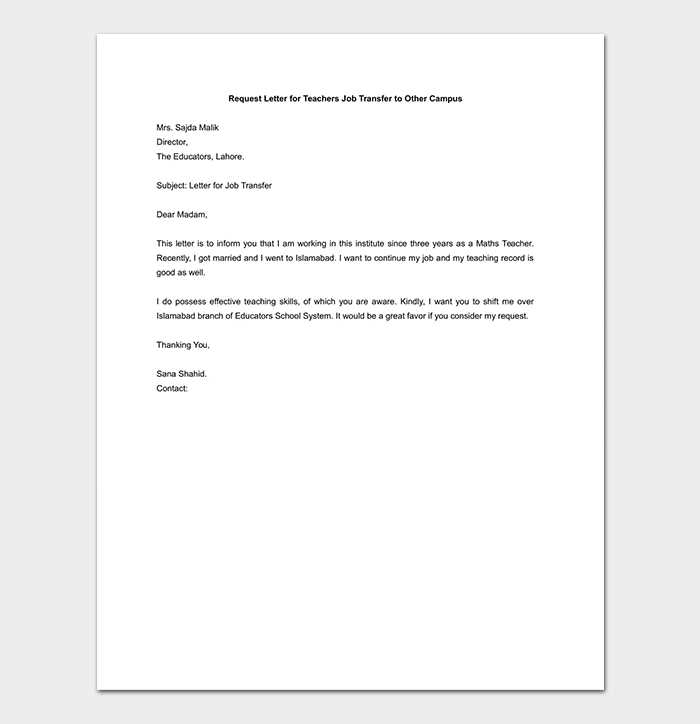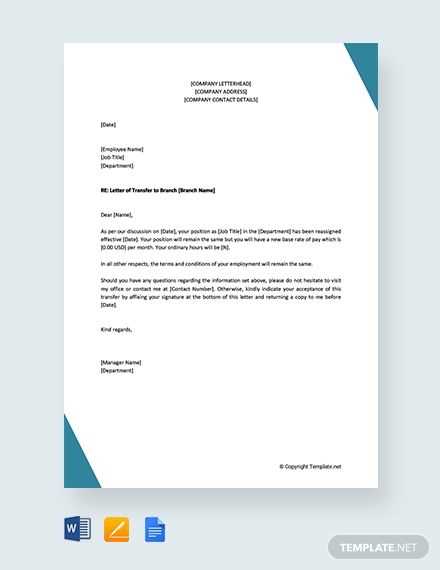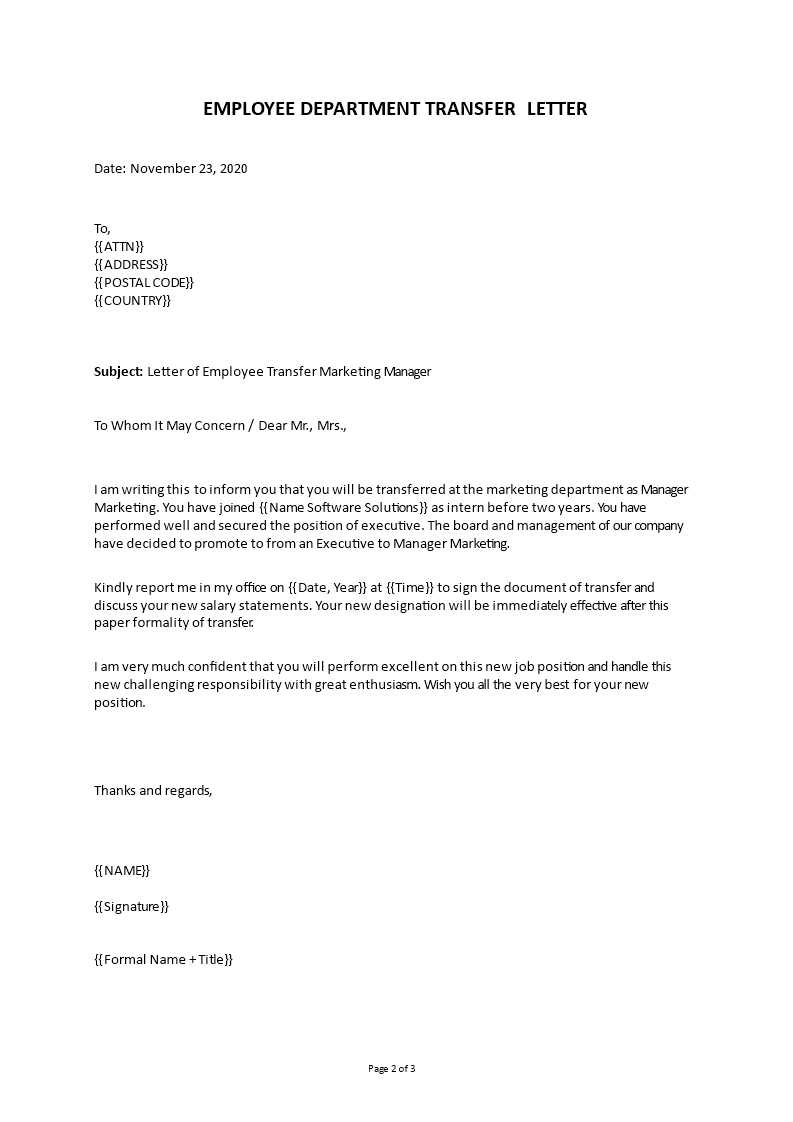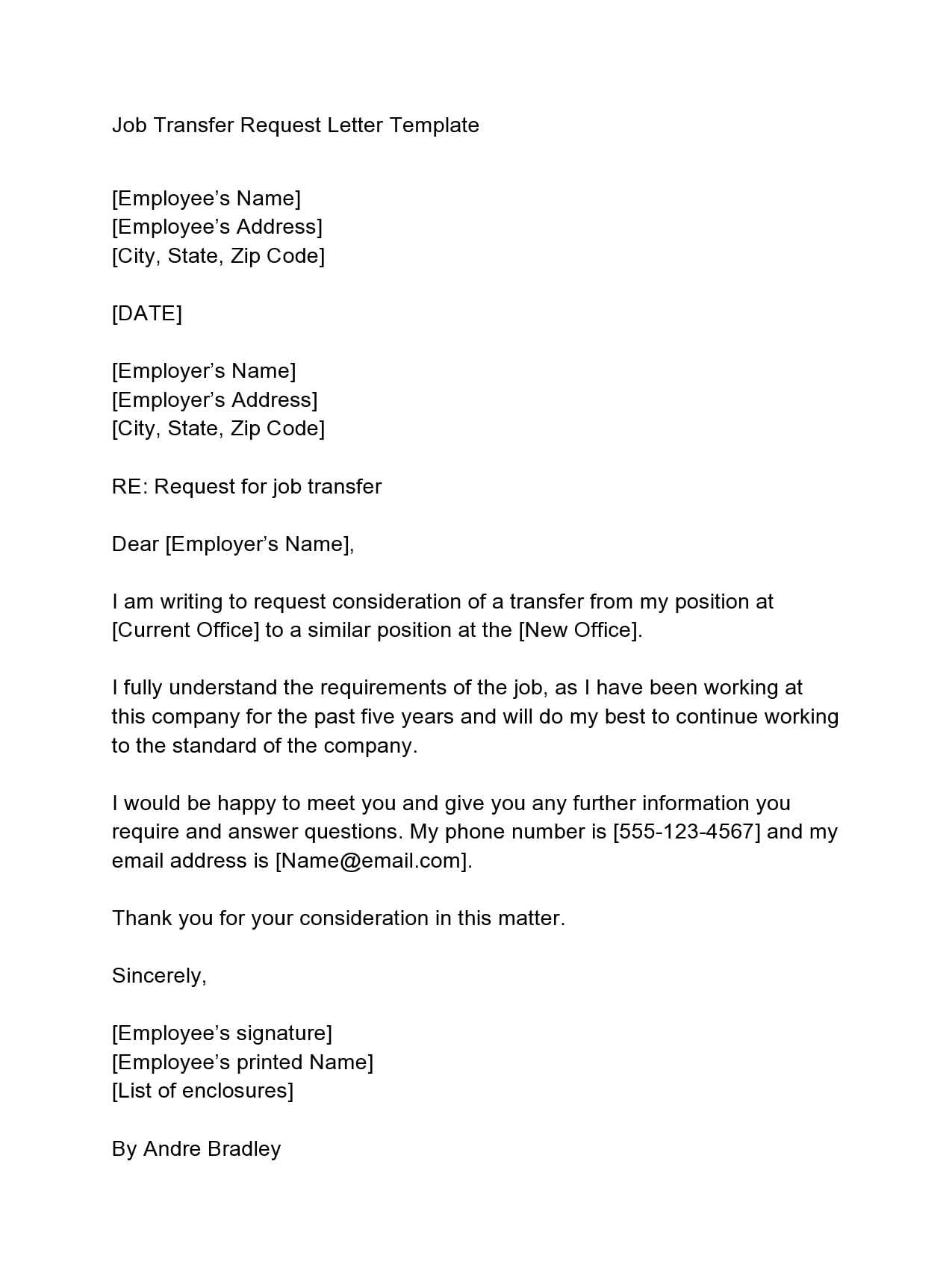Transfer letter to employee from one location to another template

To facilitate a smooth transition, providing your employee with a clear and structured transfer letter is key. This document ensures that both parties understand the expectations, responsibilities, and logistics surrounding the move. A well-crafted transfer letter includes all necessary details, such as the employee’s new role, the start date at the new location, and any adjustments in compensation or benefits.
Use the template below as a guide to draft a transfer letter that covers all relevant points, avoids ambiguity, and maintains a professional tone. Tailor the template based on your company’s policies and the specifics of the employee’s situation, ensuring the communication is transparent and supportive.
Template for Transfer Letter
Dear [Employee Name],
We are writing to confirm your transfer from your current location at [Current Location] to [New Location], effective from [Transfer Date]. In your new role as [New Job Title], you will be reporting to [New Supervisor’s Name] and responsible for [Key Responsibilities]. We believe this move will support your career growth and contribute to the overall success of the organization.
We have outlined the following details to assist you in your relocation process:
- New Work Location: [New Location]
- Start Date: [Transfer Date]
- Reporting Manager: [Manager’s Name]
- Relocation Assistance (if applicable): [Details]
- Compensation/Benefits Changes (if applicable): [Details]
If you have any questions or need further clarification, please feel free to reach out to [HR Department or Manager’s Name]. We are here to support you throughout this transition.
We look forward to your continued success in this new chapter of your career with us.
Sincerely,
[Your Name]
[Your Job Title]
[Company Name]
Here are the corrected lines without word repetition, maintaining the meaning and proper grammar:
Ensure the letter clearly indicates the employee’s name, current position, and the transfer details. Avoid redundancy by using varied sentence structures and avoiding repeated terms like “position” or “location” unless necessary.
| Before Correction | After Correction |
|---|---|
| “The transfer of the employee to the new position at the new location will be effective starting next month.” | “The employee’s transfer to the new role at a different location will take effect next month.” |
| “This transfer will allow the employee to gain more experience in the new role at the new location.” | “This move offers the employee the chance to gain experience in the new role and location.” |
| “We hope that the transition to this new position at this new location will be smooth for you.” | “We wish for a smooth transition as you move into the new role at a different location.” |
Refine the language to avoid repeating the same words. Using synonyms or rephrasing ensures clarity and keeps the communication fresh. Always focus on the purpose of the transfer and the impact on the employee’s role, not the location or position repetitively.
- Transfer Letter to Employee from One Location to Another Template
To ensure a smooth and clear transition for your employee moving from one location to another, it’s important to include key details in the transfer letter. This template outlines how to communicate the move professionally while maintaining clarity and positive tone. Here is a recommended structure for your transfer letter:
Letter Content

Begin by addressing the employee personally. Start with a formal greeting, followed by a clear statement about the transfer and the new location. Mention the reason for the transfer if necessary, especially if it involves changes in role, responsibilities, or personal circumstances.
Provide the effective date of the transfer and any logistical details such as relocation assistance, if applicable. Clarify whether the transfer is temporary or permanent, and any adjustments to salary or benefits, if relevant. Be sure to mention support offered during the transition phase, such as orientation at the new location or any necessary training.
End the letter with an encouragement and assurance, ensuring the employee feels supported and valued as they make the transition. Use a closing line that expresses your confidence in their ability to adjust and thrive in the new role or location.
Transfer Letter Template
Below is a basic template you can adapt to suit your specific needs:
[Your Company Name] [Company Address] [City, State, Zip Code] [Date] [Employee's Name] [Employee's Job Title] [Employee's Current Address] [City, State, Zip Code] Dear [Employee’s Name], We are writing to inform you that, effective [Date], your position will be transferred from [Current Location] to [New Location]. This decision has been made as part of our company’s strategic plans, and we are confident that this change will provide new opportunities for your growth and success. We understand that this is an important move, and we are committed to supporting you during this transition. [Company Name] will assist with [mention any relocation assistance, travel reimbursements, etc.] to ensure a smooth relocation process. Please feel free to reach out to [HR Contact Name or Department] for any questions regarding this transfer or the relocation process. Your new role at [New Location] will include [mention any new responsibilities, changes, or support offered], and we are certain you will continue to contribute greatly to the team’s success. We appreciate your continued dedication and look forward to your contributions in the new location. If you have any concerns, do not hesitate to reach out. Sincerely, [Your Name] [Your Position] [Company Name]
Ensure to customize the template based on specific circumstances, such as temporary assignments or long-term relocations. Clear communication will help both you and the employee manage expectations during this process.
A transfer letter should be clear, concise, and structured. Make sure to include these key elements to ensure the communication is thorough and effective.
1. Employee Information
Start by stating the employee’s full name, current position, and the department they are part of. This helps identify the individual being transferred and provides context for the change.
2. Details of the Transfer

Clearly mention the new location, department, and role the employee will be moving to. Include the date the transfer will take effect. This allows the employee to understand the specifics of the move.
3. Reason for the Transfer
Outline why the transfer is taking place. Whether it’s for business needs, personal development, or organizational changes, provide a brief explanation to help the employee understand the purpose behind the decision.
4. Reporting Structure
Indicate the employee’s new supervisor or manager. If the reporting structure changes, clarify these details to prevent confusion about the new expectations and responsibilities.
5. Transfer Conditions
If there are any specific conditions tied to the transfer, such as a probation period or new job requirements, include them here. This sets clear expectations going forward.
6. Benefits or Adjustments
Outline any changes to the employee’s compensation, benefits, or working hours that may arise due to the transfer. This ensures transparency and avoids misunderstandings.
7. Acknowledgment

Conclude by stating that the employee is expected to acknowledge and confirm their understanding of the transfer. You can include a space for the employee’s signature or a statement requesting a written confirmation.
| Key Element | Details |
|---|---|
| Employee Information | Name, Position, Department |
| Transfer Details | New Location, Role, Date of Transfer |
| Reason for Transfer | Business, Development, Organizational |
| Reporting Structure | New Supervisor or Manager |
| Transfer Conditions | Probation Period, New Requirements |
| Benefits/Adjustments | Compensation, Benefits, Working Hours |
| Acknowledgment | Employee Confirmation |
Clearly outline the relocation date and the expectations regarding the transition. Specify the exact date when the employee is expected to begin working at the new location. This helps both parties plan for any necessary adjustments.
- Provide the start date for the new location along with any overlap period between the old and new positions, if applicable.
- Specify the timeline for completing any necessary paperwork or formalities before the move.
- If there are any pre-move preparations, such as training or meetings, make sure to mention them in the letter to ensure the employee is well-prepared.
- Clarify the support available to assist with the transition, such as relocation assistance, travel arrangements, or temporary housing, if provided.
Establish expectations for the employee’s involvement during the relocation process. This might include completing specific tasks or reporting on relocation progress, ensuring that the transition remains smooth and efficient.
Specify the employee’s new position and duties clearly to avoid any confusion. Outline key responsibilities, day-to-day tasks, and expectations that will come with the new role. If there are any changes in the reporting structure or team dynamics, mention them directly. This ensures the employee has a clear understanding of their position and how it fits within the company’s objectives.
Be transparent about any adjustments to the role’s scope, including additional tasks or removal of previous duties. Providing details about any new goals, performance targets, or specific projects will help the employee transition smoothly and know exactly what is expected in the new position.
If the location change involves a shift in work hours, team size, or operational processes, include these details in the letter. This allows the employee to prepare mentally for the new environment and responsibilities, helping them settle in faster and contribute effectively from the start.
Clearly outline any changes to compensation and benefits for the employee when transferring locations. Transparency is key, so provide a detailed breakdown of the adjustments, ensuring the employee fully understands the new terms.
- Salary Adjustments: Specify any increases or decreases based on the cost of living in the new location, job responsibilities, or other relevant factors. Use a simple comparison between the current and new salary to make the shift clear.
- Bonuses and Incentives: If applicable, outline any changes in bonus structures or incentive plans, ensuring the employee understands how their performance will be rewarded in the new location.
- Benefits Changes: Address any differences in healthcare, retirement plans, or other benefits due to the transfer. If the employee’s benefits package will remain the same or undergo changes, communicate this clearly.
- Relocation Support: Include details about any relocation assistance provided, such as moving expenses, temporary housing, or reimbursement policies. Be specific about what is covered and the process for accessing these benefits.
Provide written confirmation of all adjustments in the transfer letter and ensure the employee knows who to contact for further clarification on their compensation and benefits. Transparency reduces confusion and sets the tone for a smooth transition.
Focus on clarity and transparency from the start. Ensure the employee understands all relocation details, such as new job responsibilities, reporting structures, and any changes in benefits or compensation. Clear communication helps avoid misunderstandings and ensures a smooth transition.
Logistics and Support
Provide practical support for moving, such as housing assistance, moving company referrals, and settling-in services. Offering guidance on local amenities, schools, or transportation can help the employee adjust quickly to the new location.
Timeframe and Expectations
Set realistic timelines for the move. Allow the employee enough time to plan the relocation while keeping the business’s needs in mind. Be flexible with work arrangements during this period, ensuring the employee can handle both work and moving tasks effectively.
- Consider offering a phased relocation process if the move is significant.
- Set expectations for how long the transition will take, from settling in to becoming fully operational in the new location.
Addressing these details upfront minimizes stress and builds trust, making the relocation process a positive experience for the employee and the company.
When issuing a transfer letter, ensure that it complies with both legal requirements and company policies. The letter should clearly specify the employee’s new location, role, and any adjustments to salary or benefits, if applicable. Legal implications often involve adhering to labor laws regarding employee relocation and ensuring that any changes to terms of employment are clearly documented.
Consult your company’s internal policies to confirm whether the transfer requires approval from specific departments, such as HR or legal. Additionally, ensure the transfer aligns with any union agreements or collective bargaining terms that may apply to the employee’s current role.
It’s important to address potential legal concerns, such as relocation assistance and notice periods. Make sure to specify whether the company will cover relocation costs, and ensure the employee’s rights to severance or continued benefits remain intact throughout the process. Clarify any requirements for advance notice to ensure compliance with labor contracts and laws.
Transfer Letter Template for Employee Relocation
Ensure your transfer letter includes key details like the employee’s current position, new location, effective date, and any changes in responsibilities. Clearly mention the reasons for the transfer and provide specific instructions for the employee’s transition.
Start the letter by addressing the employee personally and stating the purpose of the transfer. Outline the new location’s address, department, and any adjustments in work hours or conditions. Include relevant contact details to help the employee get in touch with the new office if needed.
Detail any required paperwork or training associated with the transfer. Indicate whether there are new expectations for the employee in the new role and how performance will be evaluated. Offer support for relocation logistics, such as housing or transportation options, if applicable.
Conclude by expressing appreciation for the employee’s contributions and encouraging them to reach out with any questions or concerns. Reinforce the commitment to supporting their transition smoothly.